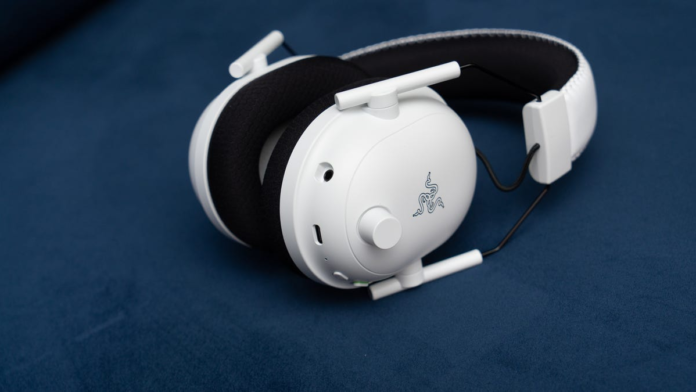Razer BlackShark V2 Pro 2023 $200 at Razer Like Lightweight
Lightweight Nice mic quality and solid audio Don’t like No more 3.5mm analog jack or other support for wired operation
No more 3.5mm analog jack or other support for wired operation Nonreplaceable ear cushions
Nonreplaceable ear cushions Can’t use Bluetooth and 2.4GHz simultaneously
Razer released its BlackShark V2 Pro esports-targeted wireless gaming headset in September 2020. At the time I liked it a lot for its comfort and its light weight. Since then, a lot has changed in the headset category, enough that the V2 Pro was starting to get a bit worn around the edges for a flagship for the range. But I guess it’s not so worn that Razer wanted to go all out with a V3. So the company’s updated it and tagged the new model with “2023,” adding Bluetooth and a new microphone plus some design and operational tweaks. All to mixed results.
You can buy the BlackShark V2 Pro 2023 now for $200 (£200, AU$350), $20 more than its predecessor was at launch. If you don’t need the Bluetooth or the better mic — and it’s good, but not where-have-you-been-all-my-life better than the older model — then you won’t miss much by opting for that and saving $70.
The new mic has a pop filter built in so you may not need to use the bundled foam cover. Lori Grunin/CNET
I liked the old mic, but the new mic (dubbed “Super Wideband” thanks to an increase to 32kHz sampling from the simply “Wideband” 16kHz SuperCardiod mic in the earlier model) really is a step up. It’s capable of a fuller, warmer sound that’s still crisp enough for chat.
In addition to the bundled foam pop filter, there’s one built into the mic. It really does make a difference. So if you think the fat foam covers can get awkward — they can get lost and catch dust and crumbs! — it’s a big help. The mic supports software noise cancellation, which works well, but that’s only available with Razer’s Synapse utility. It’s still removable, albeit with a slightly stiffer boom, but there’s still no indicator to show that it’s muted.
In adding Bluetooth, Razer made the headset more usable with consoles and mobile devices — always a plus. But Razer sacrificed the analog wired connection, which doesn’t thrill me — having wired is useful as a backup if the wireless decides to go wonky on you or if you need to diagnose any wireless connection issues — but, sadly, it’s a common move. The Bluetooth operation is typical of Razer’s headsets: It doesn’t support simultaneous Bluetooth and 2.4GHz wireless except for notifications.
For example, that means you can listen to music on your phone and work on your PC, but if you click on a web page that has any media elements on it, even if they’re muted, it stops the music. (Muting the tab or site to prevent that works, though.) Synapse has a do-not-disturb mode that can prevent Bluetooth from interrupting gameplay.
On the left earcup are the mute and power buttons, USB-C connector for charging and jack for the removable mic. On the right is the SmartSwitch button which controls Bluetooth and cycling through equalization profiles. Lori Grunin/CNET
One of the tweaks is a slightly stiffer headband, with, as Razer says, “refined clamping force.” Unfortunately, it’s enough of a change that the headset’s gone from “oooh, comfy” to “ouch, it’s pressing on my jaw,” despite (or maybe because of) squishier padding. At least on my head: Your mileage may vary. It helps that it remains a lightweight at 11.3 ounces (320 grams), though.
Now you can cycle equalizer profiles on-ear, including one custom profile which is downloaded via Synapse. In the rotation are custom tuned profiles for a handful of competitive games: Apex Legends, COD, CS:GO, Fortnite and Valorant.
You can’t toggle surround sound, which makes sense since you have to be running Synapse to use it. The BlackShark, unsurprisingly, uses Razer’s THX surround, which I’m not a huge fan of. It’s fine for ambient surround, like listening to random conversations going on around you. I’ve never liked it much for locating sounds like footsteps or gunshots, since my ears find the sound waves have too broad a source for precisely locating them. (For ambient noise, “behind me” is narrow enough.) At the moment there are about 45 games with THX support; that’s not a lot, only up from 16 since the V2 launched in 2020. Half of them are competitive games, which makes sense.
Razer says the battery life has increased to 70 hours from 24, but I don’t know what kind of conditions that’s under. I didn’t see nearly that much; I extrapolate I’d get closer to 50 hours at most, based on my mixed use. Still, it’s not bad. And you can charge while using them — Razer switched to USB-C from micro USB, and the company claims you can get 6 hours per 15 minutes of charge time.
Receiver range hasn’t changed, but Razer now includes a USB extender for the dongle. That might address some of the complaints I’ve read about the older model’s poor 2.4GHz wireless signals, which can be caused by the receiver’s proximity to other devices in your system. Still, I’ve found the range to be about 30 feet with some walls in between.
If you don’t have issues with headset fit — I seem to have more problems with pressure on the sides of my head than most, but I guess princess meets pea — and don’t care about the lack of a wired connection, then the Razer BlackShark V2 Pro certainly merits consideration.
Razer BlackShark V2 Pro 2023 Review: Still a Lightweight
RELATED ARTICLES




